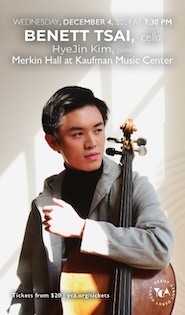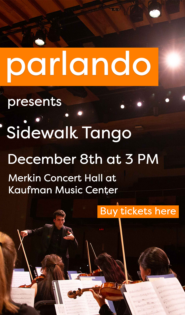Narucki, Macomber tease and dazzle in Kafkaesque Kurtág

Ever since its composition in the mid-1980s, Kafka Fragments, György Kurtág’s song cycle for soprano and violin, has fascinated listeners with its combination of gem-like concentration and vast power of suggestion. No less an authority than the writer and statesman Václav Havel pronounced it “a true Central European encyclopedia.”
The audience at Saturday’s hour-long performance of the work by soprano Susan Narucki and violinist Curtis Macomber were hearing a singer who has been living with this work since before it was published, the composer himself having placed a copy in her hands after she performed his music at a festival in 1986.
The concert’s setting, the art gallery of the Tenri Cultural Institute on West 13th Street, put a congruent frame of Japanese minimalism around the performance. The singer marked each of the work’s four sections by turning her back to the audience and briefly contemplating a large image of a temple scene on the wall.
Kurtág, who like his longtime friend György Ligeti was born in Romania to Hungarian Jewish parents, began collecting bits and pieces from Franz Kafka’s diaries long before setting them to music. Some were provocative aphorisms akin to Blake’s Proverbs of Hell: “Wrap your overcoat, O lofty dream, around the child.” “Once I broke my leg: it was the most wonderful experience of my life.” And (titled “Penetratingly Jewish” by Kurtág), “In the struggle between yourself and the world, side with the world.”
Others captured a fleeting, haiku-like image: “Someone tugged at my clothes but I shrugged him off.” “The onlookers freeze as the train goes past.” “Like a pathway in autumn: hardly has it been swept clean, it is covered again with dry leaves.”
The composer strung together 40 of these in brief settings, some lasting only long enough to sing one line of text.
Like Ligeti and other composers of that generation, Kurtág didn’t escape the influence of Bartók in his youth. It was still audible in this piece’s violin part, which swung between choppy down-bows, eerie passages in minor seconds, nocturnal hums and harmonics, and a folk-style movement titled “Hassidic dance.” Expressionistic whoops, shrieks, sighs, and Sprechstimme occasionally punctuated the vocal line.
But it was Kurtág’s later encounter with Webern’s say-it-and-be-done aesthetic that shaped these tiny statements and their disjunct vocal lines.
Kurtág was an admirer of Robert Schumann as well, and some of the character of the latter’s piano cycles, with their enigmatic allusions and subjective flow, rubbed off on this piece. By Kurtág’s account, he went back at least once and reordered the songs to make more musical sense.
Accordingly, Narucki’s rendering of the German texts emphasized musical phrasing over lieder-style diction. Kafka’s words lurked in the background, a jumping-off point for the voice as another instrument duetting (or dueling) with the violin. At times, one could close one’s eyes and imagine a flute curling among the violin’s double stops, making throbbing acoustical “beats” with it.
At the same time, Narucki lacked nothing in musical articulations ranging from jittery staccato to dizzy slides to fluttering tremolo, to say nothing of her sleek phrasing in legato passages.
Macomber matched her with sinuous lines in a plain, non-vibrato style, resonant or grating double stops, and effects such as harmonics and left-hand pizzicato—virtuosity in service to the score, not just for display.
The score contains occasional stage directions, evoking a Beckett-like theater of hidden meanings and sudden revelations. On Saturday, Narucki and Macomber sometimes broke chamber-music convention and confronted each other directly, the singer driving her point home or, in one instance, the violinist silencing the singer with a furious outburst as her lips moved soundlessly. (Kurtág’s only opera to date is an adaptation of Beckett’s Endgame.)
The performers’ theatricality was tempered by a fog of alienation emanating from Kafka’s mind and presiding over the whole event. That the performance could be so expressive in that context was yet another paradox to contemplate.


Posted Apr 04, 2024 at 7:29 am by Alba Potes
Thank you for publishing reviews. Sadly, in general there are very few reviews. They are important for raising the education of the listeners about music, to attract new listeners, and to create a sense of belonging to the club of music lovers. They are important for the performers and the composers, as well. I really liked this review because I found it very enriching, detail oriented, optimistic and because invite the reader to keep exploring the music of György Kurtág.
Warmest regards,
Alba Potes